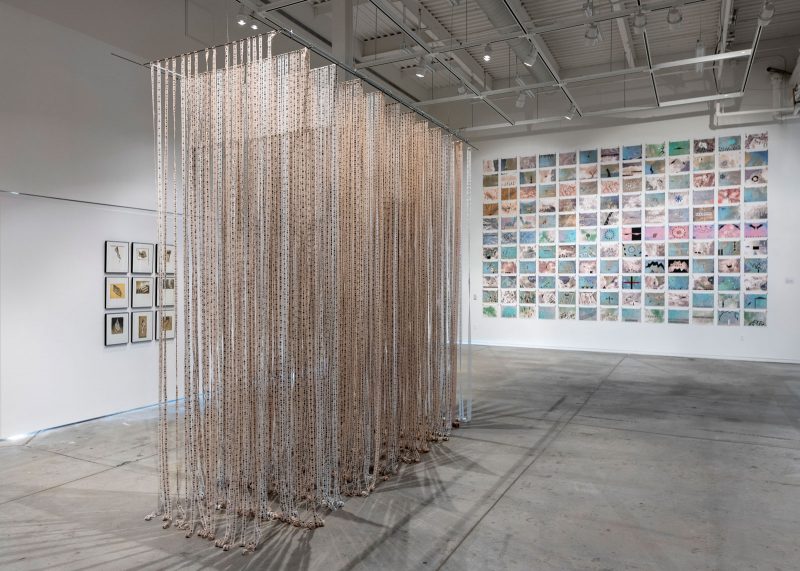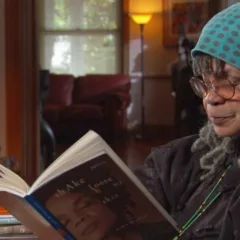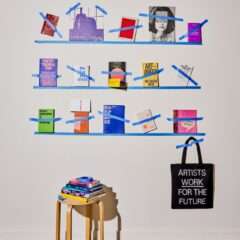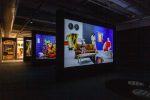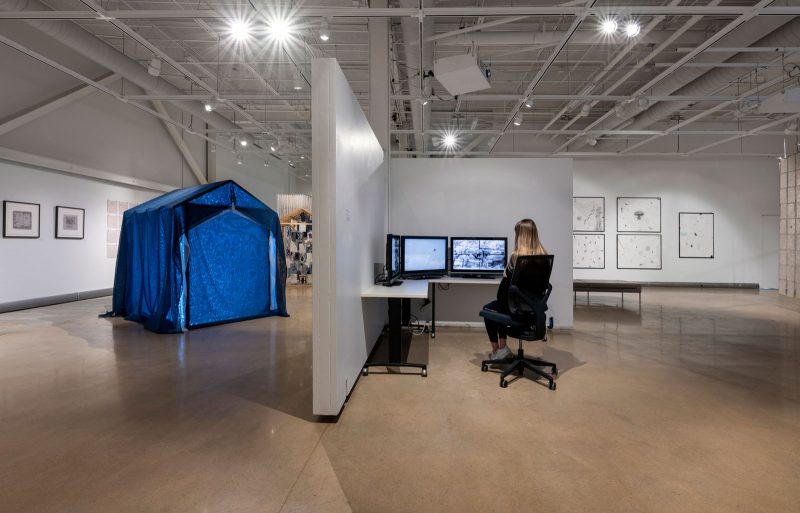
For more than twenty years Linda Bond has studied the news as an artist/citizen, examining public information released by the U.S. Government and/or published by reputable news sources, primarily the New York Times. She has focused on the attacks of September 11, 2001 and the U.S. response to them, including wars in Iraq, Afghanistan, and Pakistan. She has read the entire Mueller report and followed news of international and domestic events including the immigration crisis, ongoing racial injustice, and President Trump’s Twitter statements.
Her artwork has been a tenacious effort to understand incomprehensibly-large numbers and to see the individuals behind them: those displaced and killed by advanced weaponry; and the soldiers who controlled the drones, observing the results of their decisions in real time, aerial views detailed enough to see individuals as targets. She has observed enormous campaigns of destruction described by bureaucratic euphemisms that the government employs for warfare in which, increasingly, no U.S. lives are at risk. The dense, twenty-year retrospective, Errors and Omissions, at the Leonard Pearlstein Gallery, Westphal College of Media Arts and Design, Drexel University (through Feb. 20, 2022) presents work from fifteen different series; the exhibition is exquisitely beautiful, extremely disturbing, and impossible to forget.
Bond has employed several approaches throughout her carefully-researched work: citation of both text and illustrations, most of which are newspaper photos in black and white; enumeration, in which she converts the abstraction of numbers into material form, iterated as a means of understanding; and a sort of homeopathic use of materials associated with combat and reportage as the physical media of her art. She works across a variety of techniques and formats including drawing, collage, monoprint, digital projection, single and multi-screen video, and installations in various materials; one of the installations here involves audience participation.
The exhibition opens with two large drawings, “Smoke V (New York)” and “Smoke VI (Qulai Bashi, Afghanistan”), 2002; Bond had been studying smoke clouds and was struck by how much the image of U.S. bombing in Afghanistan resembled photographs from the destruction of the World Trade Center. The most obvious difference is the feint vertical pattern in the background of the New York drawing, identifiable to anyone who knew them as the architecture of the towers. Below the drawings is a diptych on panel, “Collateral Damage.” The left panel is based upon a rubbing Bond did of the New York Times‘ story published one year after the towers were destroyed, which included head shots of every person killed by the attacks; they are pale but legible shadows on a white ground. The right-hand panel is black on black, a relic of the transfer process to which the artist added a fingerprint on each of the portraits – the first example we see of her enumeration, as well as the record of touch used to acknowledge the human loss each news image represented.
The next work, “Outcome” 2010, is a large drawing (36” x 36”) done in gunpowder and graphite. The use of gunpowder as a drawing medium is Bond’s own invention and one she uses regularly from this time forward. The drawing is an extremely-detailed enlargement of a newspaper photo: a soldier, seated with bowed head, rubs away tears with his right hand. It is an eternal image of a soldier’s grief. I immediately thought of the current Jasper Johns exhibition at the Philadelphia Museum of Art, where a number of works from 2014 incorporated a Vietnam-era newspaper image of the same subject, Larry Burrows’ “Farley Breaks Down,” a grieving soldier, head in hand. Bonds’ extraordinary effort of accurate rendering conveys a visceral respect for its subject.
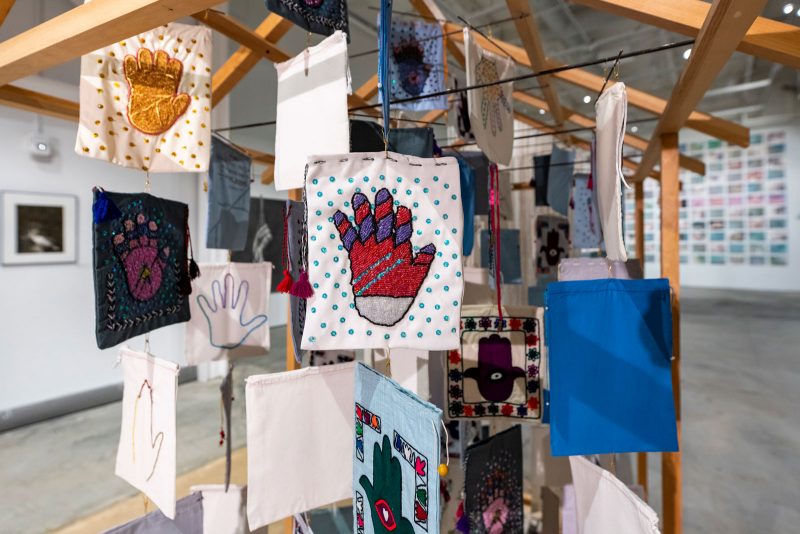
Next to the drawing is “a count,” 2010-15, a delicate, semi-transparent, hanging screen formed of gauze bandages, actual WWII and Vietnam-era bandaging that Bond sourced through Ebay. She researched the sum of the death counts from both Iraq and Afghanistan – not readily available but pieced together from multiple governmental sources and of questionable accuracy – and using an ink made from gunpowder, she left a fingerprint for each individual who died – as if to say “I acknowledge a life and the loss to loved ones.” The indefiniteness of the title indicates the uncertainty of the numbers and the likelihood that there are more to account for.
On the wall behind “a count” hangs the “Flag Series” (2011), a grid of nine, modestly-sized drawings of U.S. flags, all taken from published photos and executed in gunpowder wash. Their power and poignancy are astonishing. One of the flags covers a coffin, another is a disordered pile of fabric, but most are hanging or flying from poles and none have backgrounds that place them. One flag is tattered to shreds. The series makes it clear that the flag is a malleable symbol that no one owns; its meaning depends on the circumstances of its display and on its viewers. The flag of nationalistic pride is also the flag of protest, and it is as contested a symbol as the republic for which it stands — a nation exploitatively-divisible at present, the deity invoked for partisan purposes, its liberty and justice for some, not equally for all. Beside the grid of small flags is one of the largest drawings in the exhibition, “Remembering” (60” x 60”). It also depicts a flag, and even from the tightly-cropped cropped image we can tell that it is flying at half mast. The question we are left with: in mourning for whom?
The entire, huge back wall of the gallery is the setting for “Inventory,” 2011- ongoing. It is covered with a grid of postcards hanging on small nails, each illustrating either a Glock pistol or an AK47 rifle; the occasional postcard is missing. They represent a fraction of the 80,000 pistols and 110,000 automatic rifles that the U.S. Government has acknowledged it imported into Iraq and could not account for. That’s 30 per cent of all the weapons brought into the country. On the floor are additional post cards, bundled in batches the size of bricks. How does one comprehend numbers like these?
Visitors are invited to take a postcard, or several. They can be kept or given to others. The cards are inscribed on the reverse with identifying numbers and records of the sites of their prior exhibition. They can be registered at a laptop computer sitting beside the installation, or by sending them back to Bond – a mailing address is given. The order and control of Bond’s inventory is in shocking opposition to the unaccounted-for military weapons and their deadly consequences. Bond is keeping track of the transmission of the postcards, these symbolic weapons in circulation, that will cause no deaths.
Linda Bond’s work is conceptually sophisticated, exquisitely executed, and provocative in effect. It is also striking in its openness to interpretation. While her works on the missing weapons in Iraq or the number of war dead in the Middle East are clearly critical, they do not point fingers or direct specific blame. Her art is an attempt to situate her own involvement in the ongoing, messy and violent history of the United States in the Twenty-first Century. She offers us the option to join her in confronting events we might prefer to ignore and in paying attention to the nameless individuals who suffered and died at the initiatives of a wealthy and powerful country that aspires to something better.
Linda Bond, “Errors and Omissions” is on view through Feb. 20, 2022 at Leonard Pearlstein Gallery at Drexel University.
